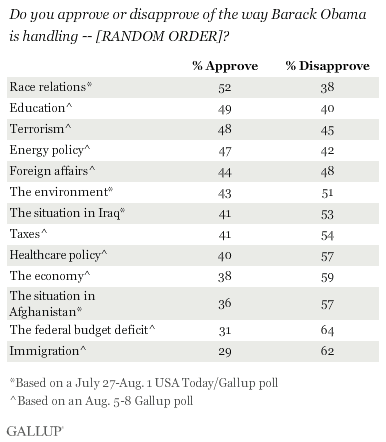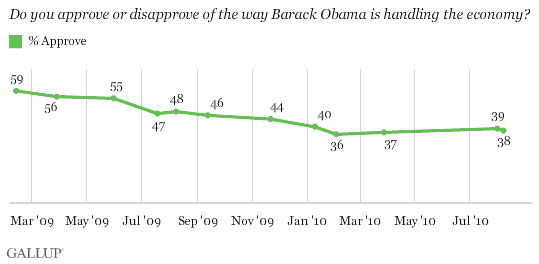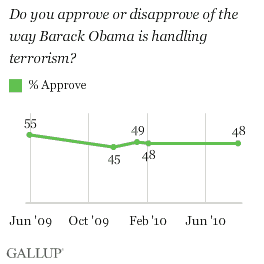PRINCETON, N.J. -- Barack Obama's 52% approval rating for handling race relations is the only issue among 13 tested in two recent Gallup polls for which the president receives majority-level approval. In fact, a majority disapprove of the job the president is doing on eight of these issues, with his worst scores for his handling of immigration and the federal budget deficit.

These results are based on a USA Today/Gallup poll conducted July 27-Aug. 1 and a separate Gallup poll conducted Aug. 5-8, which asked Americans to say whether they approve or disapprove of the way the president is dealing with each of several issues. Both polls measured Obama's handling of the economy, which Americans rated essentially the same in each (39% and 38%, respectively).
Obama's generally tepid evaluations on issues are not surprising considering his overall job approval rating has consistently been below 50%.
There is no clear pattern for how Americans rate the president on international versus domestic issues. For example, on the international side, respondents rate him relatively well for how he has handled terrorism but poorly for his handling of the situations in Iraq and Afghanistan. On the domestic side, Obama gets fairly high ratings for handling race relations and education but respondents rate him poorly for handling immigration, the federal budget deficit, and the economy.
Economic Ratings Remain Depressed
With the economy ranking as the top problem in Americans' minds, Obama's ratings for handling the economy are important to his and his party's political fortunes. His economic approval ratings are generally weak, at 38% approval. Although these are down significantly from last year, they have not gotten appreciably worse in 2010.

That same general pattern of declining ratings in 2009 and flat ratings in 2010 also applies to Obama's ratings on terrorism and the federal budget deficit, two other issues Gallup has measured on a regular basis during Obama's presidency.


In contrast, Obama's ratings on international issues -- including the two ongoing wars -- have deteriorated this year. In the case of Afghanistan, the decline is due in part to a bump in his rating after he announced his new strategy for that war late last year.


Implications
Less than a majority of Americans give Obama a positive review for the job he is doing as president overall, and the same applies to their opinions of how he is handling most of the issues he is having to contend with as president.
In general, the public could rate the president poorly on issues for three major reasons. One is a perception that the president is not doing enough to address a problem facing the country, which some could argue applies to the Obama administration handling of immigration and the federal budget deficit. A second possibility is the president has taken obvious action to address a problem but Americans do not necessarily agree with the approach he has taken, which could apply to Obama and the healthcare policy. A third possibility is that Americans may support the president's policies but are disappointed by the lack of progress on an issue, which could apply to Obama and Afghanistan and possibly the economy as well.
Results are drawn from two surveys.
A USA Today/Gallup poll consisting of telephone interviews conducted July 27-Aug. 1, 2010, with a random sample of 1,208 adults, aged 18 and older, living in the continental U.S., selected using random-digit-dial sampling. For results based on the total sample of national adults, one can say with 95% confidence that the maximum margin of sampling error is ±3 percentage points.
A Gallup poll consisting of telephone interviews conducted Aug. 5-8, 2010, with a random sample of 1,013 adults, aged 18 and older, living in the continental U.S., selected using random-digit-dial sampling. For results based on the total sample of national adults, one can say with 95% confidence that the maximum margin of sampling error is ±4 percentage points.
Interviews are conducted with respondents on landline telephones (for respondents with a landline telephone) and cellular phones (for respondents who are cell phone only). Each sample includes a minimum quota of 150 cell phone-only respondents and 850 landline respondents per 1,000 interviews, with additional minimum quotas among landline respondents for gender within region. Landline respondents are chosen at random within each household on the basis of which member had the most recent birthday.
Samples are weighted by gender, age, race, education, region, and phone lines. Demographic weighting targets are based on the March 2009 Current Population Survey figures for the aged 18 and older non-institutionalized population living in continental U.S. telephone households. All reported margins of sampling error include the computed design effects for weighting and sample design.
In addition to sampling error, question wording and practical difficulties in conducting surveys can introduce error or bias into the findings of public opinion polls.
View methodology, full question results, and trend data.
For more details on Gallup's polling methodology, visit https://www.gallup.com/.
